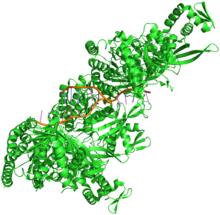RecA
| recA bacterial DNA recombination protein | |||||||||
|---|---|---|---|---|---|---|---|---|---|

|
|||||||||
| Identifiers | |||||||||
| Symbol | RecA | ||||||||
| Pfam | PF00154 | ||||||||
| Pfam clan | CL0023 | ||||||||
| InterPro | IPR013765 | ||||||||
| PROSITE | PDOC00131 | ||||||||
| SCOP | 2reb | ||||||||
| SUPERFAMILY | 2reb | ||||||||
|
|||||||||
| Available protein structures: | |
|---|---|
| Pfam | structures |
| PDB | RCSB PDB; PDBe; PDBj |
| PDBsum | structure summary |
RecA is a 38 kilodalton protein essential for the repair and maintenance of DNA. A RecA structural and functional homolog has been found in every species in which one has been seriously sought and serves as an archetype for this class of homologous DNA repair proteins. The homologous protein is called RAD51 in eukaryotes and RadA in archaea.
RecA has multiple activities, all related to DNA repair. In the bacterial SOS response, it has a co-protease function in the cleavage of the LexA repressor and the λ repressor.
RecA's association with DNA major is based on its central role in homologous recombination. The RecA protein binds strongly and in long clusters to ssDNA to form a nucleoprotein filament. The protein has more than one DNA binding site, and thus can hold a single strand and double strand together. This feature makes it possible to catalyze a DNA synapsis reaction between a DNA double helix and a complementary region of single stranded DNA. The RecA-ssDNA filament searches for sequence similarity along the dsDNA. The search process induces stretching of the DNA duplex, which enhances sequence complimentarity recognition (a mechanism termed conformational proofreading ). The reaction initiates the exchange of strands between two recombining DNA double helices. After the synapsis event, in the heteroduplex region a process called branch migration begins. In branch migration an unpaired region of one of the single strands displaces a paired region of the other single strand, moving the branch point without changing the total number of base pairs. Spontaneous branch migration can occur, however as it generally proceeds equally in both directions it is unlikely to complete recombination efficiently. The RecA protein catalyzes unidirectional branch migration and by doing so makes it possible to complete recombination, producing a region of heteroduplex DNA that is thousands of base pairs long.
...
Wikipedia
